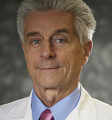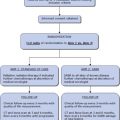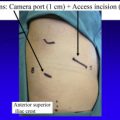The bronchoscope has gone through much advancement from its origin as a thin metal tube. It has become a highly sophisticated tool for clinicians. Both rigid and the flexible bronchoscopes are invaluable in the diagnosis and treatment of non–small cell lung cancer. Treatment of this disease process hinges on accurate diagnosis and lymph node staging. Technologies, such as endobronchial ultrasound, navigational bronchoscopy, and autofluorescence, have improved efficacy of endobronchial diagnosis and sample collection. If a patient is not a candidate for surgery and has a complication from a centrally located mass, the bronchoscope has been used to deliver palliative therapies.
Key points
- •
Bronchoscopy is a minimally invasive procedure that is versatile, has few complications, and can be both diagnostic and therapeutic.
- •
With proper training, endobronchial ultrasound (EBUS) and electromagnetic navigational bronchoscopy (ENB) have as good if not better diagnostic results than their more invasive counterparts (mediastinoscopy and transthoracic image-guided biopsy).
- •
Therapies can be delivered to centrally located airway cancers via the bronchoscope, although, for now, these are palliative in nature.
There is more hope with the bronchoscope.
Introduction
In today’s modern medical market where patients and payers want more for less, bronchoscopy has emerged as a primary tool for the diagnosis and therapy of non–small cell lung cancer (NSCLC). It requires no incisions, often requires minimal sedation, and can be performed in an outpatient setting. Flexible bronchoscopy continues to push the boundaries of diagnosing central lung lesions, peripheral lung lesions, and enlarged or metabolically active mediastinal lymph nodes. It has also become the primary tool in delivering palliative therapeutic treatments to patients with obstructive or bleeding central lung masses.
Introduction
In today’s modern medical market where patients and payers want more for less, bronchoscopy has emerged as a primary tool for the diagnosis and therapy of non–small cell lung cancer (NSCLC). It requires no incisions, often requires minimal sedation, and can be performed in an outpatient setting. Flexible bronchoscopy continues to push the boundaries of diagnosing central lung lesions, peripheral lung lesions, and enlarged or metabolically active mediastinal lymph nodes. It has also become the primary tool in delivering palliative therapeutic treatments to patients with obstructive or bleeding central lung masses.
Non–small cell lung cancer
As one of the deadliest cancers, more people die from bronchogenic cancer than from colon, breast, and prostate cancers combined each year in the United States. The American Cancer Society estimates approximately 221,200 new cases of lung cancer will be diagnosed in 2015. They also estimate approximately 158,040 deaths from lung cancer in 2015. This article focuses on the diagnosis and treatment of NSCLC using the bronchoscope.
NSCLC comprises approximately 85% of all lung cancers ; 50% to 60% of lung carcinomas are found in the periphery of the lungs. Up to 20% are found in the central zones, and the rest are in the segmental zones. In 1961, an autopsy study showed the 15% of those who died of lung cancer had carcinoma in situ in a synchronous more central location. This potentially has implications for some of the diagnostic features of newer diagnostic bronchoscopes techniques (discussed later).
General bronchoscopy: rigid and flexible
Dr Gustav Killian of Germany first used bronchoscopy to extract a piece of bone from the proximal airway in 1897. Killian went on many more times to use direct rigid bronchoscopy to remove other various foreign bodies as well as to perform examinations on volunteers to further educate himself on the living anatomy of the airway. He used rigid bronchoscopy, which is a fashioned long metal tube that has a large working channel with an internal lumen size of 6 mm to 8 mm. This working channel allows for direct visualization as well as biopsy and suction access. Rigid bronchoscopes also have a separate lumen to ventilate the patient using jet or standard techniques under general anesthesia. The patient is positioned supine with the head extended. A mouth guard is placed for protection of the patient’s front teeth as the scope is advanced through the mouth, past the oropharynx, and under the epiglottis and traverses the vocal cords.
Today, the rigid bronchoscope remains a vital technique in the diagnosis and treatment of NSCLC. Despite this, its use in patients with massive hemoptysis and central airway mass is still valuable. Advantages of rigid bronchoscopy over flexible bronchoscopy are mostly all due to its large working channel. The scope itself can then be used as an airway pushing passed obstructing masses. As such, it is recommended that a rigid bronchoscopy set be in the room whenever flexible bronchoscopy is performed for a central airway or potentially obstructing mass.
In 1967, Shigeto Ikeda introduced the first flexible bronchoscope. As its name implies, this instrument is pliable and conforms to the twists and turns of the bronchial tree. This is achievable by having the image brought to the eyepiece via bundled thin glass cables known as fiber optics. This leads to many advantages, not least of which is segmental visualization and biopsy.
The benefits of flexible compared with rigid bronchoscopy are numerous, including but not limited to patient comfort, improved diagnostics, and improved delivery of therapies. General anesthesia is not a requirement. Lack of cervical mobility can easily be navigated with flexible bronchoscopy. Also, ongoing ventilator dependence is a contraindication of rigid bronchoscopy, but a flexible bronchoscope can be advanced through an 8.0 or 8.5 endotracheal tube usually without compromising ventilation.
Instrumentation has been made for the working channel of larger flexible bronchoscopes. Fluid can be flushed through these working ports for bronchoalveolar lavage for Gram stain and cultures as well as for cytology. Brushes, forceps, snares, cautery, freezing, ultrasound probes, and needles have all been made for the purpose of either diagnostics of the airway or therapeutic interventions.
Endobronchial diagnosis of non–small cell lung cancer
Endobronchial Ultrasound
Treatment of NSCLC hinges on its stage at the time of diagnosis and as such the assessment of nodal disease is of utmost importance. Prior to the advent of endobronchial biopsy, nodal status had been determined by a surgical incision or imaging. Suspicious nodes on imaging necessitate a tissue diagnosis. This had either been done via thoracotomy, video-assisted thoracic surgery, Chamberlain procedure (anterior mediastinoscopy), or mediastinoscopy.
EBUS takes the visualization of standard white light bronchoscopy (WLB) and adds an ultrasound feature at the tip of the scope ( Fig. 1 ). Linear EBUS has the ultrasound probe tip of the scope whereas radial miniprobe EBUS is an additional piece placed through the working channel of the scope. A radial miniprobe can reach the smaller diameter bronchioles in the periphery of the lung and identify lesions using its small spinning ultrasound probe. This projects as a circular image. After a certain point, the miniprobe is necessarily advanced blindly through the bronchial tree, looking for the changes in echotexture, which signify a pulmonary mass. Diagnostic yield is enhanced with simultaneous use of fluoroscopy. A retrospective study recently showed there are certain CT findings on preoperative imaging that also increase diagnostic yield. These are lesions greater than 2 cm, lesions in certain segments (1, 3, and 6), and lesions closer to the carina, which all have statistically increased diagnostic yields of 70%, 65% to 71%, and 74%, respectively.
Accurate mediastinal staging remains important. Patients with proved stage IIIa lung cancer are more likely to undergo neoadjuvant therapy prior to their surgical resection. Newer technologies, such as navigational bronchoscopy, have increased the results of radial miniprobe EBUS by guiding the probe to a specific airway. Linear EBUS plays a large role in the staging of NSCLC and has changed the face of mediastinal nodal biopsy within the past 10 years.
Linear EBUS has a probe mounted on the end of a traditional flexible bronchoscope. A balloon around the probe is filled with saline to improve ultrasound conduction. A fine-needle aspiration needle, or more recently a larger-caliber needle that can take core size samples, can be placed in the working channel of the bronchoscope while the balloon is inflated. The needle traverses the bronchial wall at an angle and is seen within the images produced by the convex EBUS probe. This technique can easily access lymph nodes in the stations 2, 3 posterior, 4, 7, 10, and often 11.
The depth of the biopsy needle can be adjusted, as it is easily seen on the ultrasound image. Vascular structures have an absence of echotexture and are avoided. Duplex features also delineate flow through vessels, making them easily identifiable. In a 2008 study from Lee and colleagues, the number of aspirations taken from each mediastinal sample was shown to contribute to diagnostic yield. The sensitivity of EBUS with 3 aspiration attempts was 95.3% and the specificity was 100%. This was significantly increased compared with 1 or 2 aspiration attempts, with sensitivities of 69.8% and 83.7%, respectively.
A recent study from Toronto compared EBUS–transbronchial needle aspiration (TBNA) and mediastinoscopy in a prospective fashion. All 153 eligible patients received EBUS-TBNA, then mediastinoscopy. Both procedures were comparable in their ability to assess the status of mediastinal nodes. EBUS-TBNA had a sensitivity and specificity of 81% and 100%, respectively, whereas those of mediastinoscopy were 79% and 100%, respectively. Because EBUS biopsy is much less invasive, it is reasonable to perform this procedure instead of the more traditional mediastinoscopy. This is dependent on the experience of the physician and infrastructure of the institution.
Although EBUS is less invasive then surgical staging, imaging could provide improved staging less invasively. Combined and sequential CT and PET scans have both been studied as potential imaging modalities for diagnosing mediastinal involvement of NSCLC. A study from Chest in 2008 reported the findings of EBUS-TBNA in those with NSCLC and normal mediastinal nodes on CT scan and PET. EBUS-TBNA found positive nodes in 8 patients. Those who were still N0 underwent mediastinoscopy and resection with mediastinal node sampling if warranted. A further 6 patients had mediastinal or hilar lymph nodes positive and 3 patients had N1 disease. All but 1 of the N1 disease patients were identified with EBUS. This study confirms the benefit of adding EBUS-TBNA to imaging and the importance of using mediastinoscopy selectively to accurately determine nodal status without tissue diagnosis.
Electromagnetic Navigational Bronchoscopy
Up to 30% of all lung cancers are in the peripheral one-third of the lungs, placing them in the classification of peripheral pulmonary lesions. Conventional flexible bronchoscopes are typically unable to travel much beyond the segmental bronchial orifice. In the mid-2000s, an advanced bronchoscopic technique was developed that was able to access small peripheral lesions with great accuracy. This system uses computer software that recreates a patient’s bronchial tree in 3-D and creates a route from the trachea and ending at the peripheral lesion. The patient is placed on an array mat that creates an electromagnetic field around the patient. This field is able to identify a probe’s location placed through working port of a flexible bronchoscope. The combination of all these technologies is termed, ENB ( Fig. 2 ).









